 Slavery
to
Slavery
tofreedom
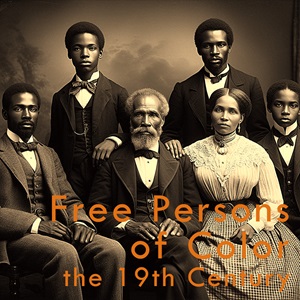

Vibrant Black communities arise
from the ashes of slavery
Midland Cemetery
Aspects of African American Burial Traditions at Midland
Aspects of African American Burial Traditions at Midland
Midland Cemetery was recently rescued from neglect by local historian Barbara B. Barksdale, who began the Friends of Midland organization That organization is the best source of information on the cemetery.
They can be contacted at the following address:
Friends of Midland, P. O. Box 7442, Steelton, Pennsylvania 17113-0442.
Midland Cemetery, located in Swatara Township, Dauphin County, Pennsylvania, is one of two African American burial grounds in the industrial town of Steelton and the nearby villages of Enhaut, Bressler and Oberlin. Time and neglect had taken their toll on the grounds of Midland, until local historians began the effort to clear and preserve the site. Most graves in Midland are now cleared and the site is marked with a sign and a memorial marker (see the intro page).
Introduction
As volunteers under the direction of local historian Barbara B. Barksdale cleared away years of brush, the site began to emerge not only as an old and historic cemetery that holds the final resting place of many of the area's African American community leaders, war veterans and leading citizens, but also as a site that exhibits numerous aspects of traditional African American burial traditions.1
East-West Interment
One of the most noticeable features of the site is that the orientation of most of the visible graves is on an east-west axis. This is a recognized feature of older slave burial grounds in the south, particularly where those interred had more direct ties to Africa.2 The orientation of many of those graves in southern burial grounds is to the east, supposedly because the deceased would then be facing the African homeland across the ocean. A second explanation, which pays homage to Christian belief, is that the dead should not have to turn around in their grave to face Gabriel when he blows his trumpet in the eastern sunrise on Resurrection Day.3 This second explanation is not exclusive to African American tradition, being found also among certain Christian beliefs in the nineteenth century. As a corollary of the second explanation, non-believers and suicides were sometimes buried facing the west.
The orientation of graves at Midland, judging from the inscriptions on the headstones and their placement, is split between east-facing and west-facing burials. This should not be taken as an indication that those persons buried facing west were interred without regard for traditional beliefs. Another African American burial tradition is to insure that the deceased is laid to rest either facing a body of water, or in prominent view of a body of water.4 The belief is that the soul of the departed will follow the water to the sea, and eventually to Africa. With that belief in mind, those westward-facing burials at Midland may have been intentionally interred to face the Susquehanna River.
Incidence of Grave Markers
After grave orientation, perhaps the most noticeable aspect of the cemetery is the relative scarcity of grave markers for the number is interments known to be here. Although the cemetery is believed to hold burials from the late eighteenth century, and was in regular use throughout the nineteenth century, grave markers from the decades preceding the Civil War have either vanished, or never existed. This is a common aspect of African American burial grounds across the country and has little to do with income or social status. Traditional African burial traditions place less emphasis on the precise spot of burial, and much importance on the place, or burial ground as a whole. Spirits of the dead are believed to linger in the general area of the burial ground, and are not tied to a specific gravesite.5 This belief carried over to the Americas, where slaves were often unable to mark a grave, or could only erect a temporary marker, such as a fieldstone, or a wooden board or stick. Permanent grave markers were viewed as unnecessary, because a deceased relative or ancestor could, and would, be honored without paying homage to a specific gravesite. Also, because families were frequently broken up or moved by the brutality of the slave system, there was no guarantee that there would be anyone around to tend an ancestor's gravesite in later years.
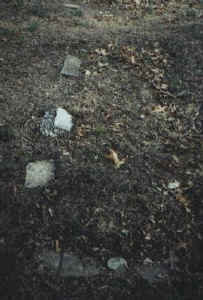 Communities of free Blacks in Pennsylvania began adopting
Christianized traditions of permanently marking graves as early as the late
eighteenth century in Philadelphia, and in the 1830's in most other parts of
the state. Older traditions carried through, however, as non-permanent
and semi-permanent grave markers persist almost to the present day.
While many nineteenth century graves at Midland were probably left unmarked,
many more were probably marked only with these temporary markers, which would
account for the paucity of surviving gravestones. Numerous depressions, sunken
ground and uneven spots in the Midland landscape attest to the presence of
these "unmarked" graves.
Communities of free Blacks in Pennsylvania began adopting
Christianized traditions of permanently marking graves as early as the late
eighteenth century in Philadelphia, and in the 1830's in most other parts of
the state. Older traditions carried through, however, as non-permanent
and semi-permanent grave markers persist almost to the present day.
While many nineteenth century graves at Midland were probably left unmarked,
many more were probably marked only with these temporary markers, which would
account for the paucity of surviving gravestones. Numerous depressions, sunken
ground and uneven spots in the Midland landscape attest to the presence of
these "unmarked" graves.
« Tombstone bases mark the edge of a small plot bordered with a low concrete curb. Sunken ground here and in the background attests to the presence of unmarked graves.
Home-crafted Grave Markers
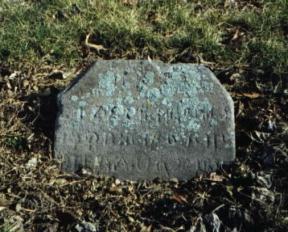 Another African American burial tradition, often erroneously
attributed to low economic status, is the use of home-crafted grave
markers. Midland Cemetery is rich with examples of such homemade
tombstones. Markers of wood, metal, cement, fieldstone and marble exist
side-by-side with professionally produced headstones. Some are very
crudely crafted, while others show considerable effort, artistic endeavor and
skill, yet lack the polish of commercial markers.
Another African American burial tradition, often erroneously
attributed to low economic status, is the use of home-crafted grave
markers. Midland Cemetery is rich with examples of such homemade
tombstones. Markers of wood, metal, cement, fieldstone and marble exist
side-by-side with professionally produced headstones. Some are very
crudely crafted, while others show considerable effort, artistic endeavor and
skill, yet lack the polish of commercial markers.
»A hand-lettered brownstone marker. The inscription, heavily worn, is not readable.
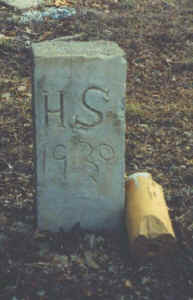 « A simple cast concrete tombstone. The inscription "HS/1930" was
inscribed in the still-wet concrete.
« A simple cast concrete tombstone. The inscription "HS/1930" was
inscribed in the still-wet concrete.
A great source of these home-crafted markers were the African American beneficial societies that were formed to aid Blacks with health care when ill, and perhaps most important, to provide a fitting burial. For modest weekly or monthly dues, the society would provide a person to prepare the body for burial, a procession to the cemetery complete with hearse and mourners, a burial plot, and a grave marker. To cut down on costs, the markers supplied were usually made and inscribed by other members of the society and included only a minimum of information. But it was not only cost that made home-crafted markers popular, but the tradition that a professionally made stone was not needed by the African American community to mark a death.6
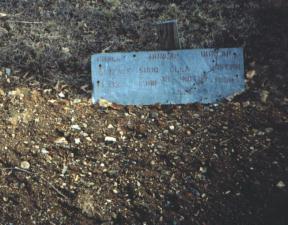 « Names stenciled on galvanized sheet metal, affixed to a plywood back. The
names are:
« Names stenciled on galvanized sheet metal, affixed to a plywood back. The
names are:
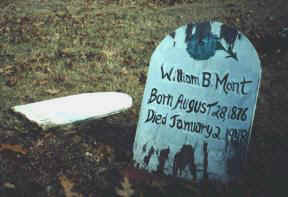 »Wooden markers. William B. Mont / Born August 28, 1876 / Died January 2,
1948. This marker shows obvious signs of having been touched-up recently with fresh paint. The picture at the top of the marker is a blue flower. The
marker is set on a brick base.
»Wooden markers. William B. Mont / Born August 28, 1876 / Died January 2,
1948. This marker shows obvious signs of having been touched-up recently with fresh paint. The picture at the top of the marker is a blue flower. The
marker is set on a brick base.
To view more photographs of home-crafted grave markers in use at Midland Cemetery, Click here.
Unique Delineation of Family Plots
Family plots came into increasing use as African American burial beliefs blended with Euro-American tradition. As stated above, traditional African burial tradition did not put as much emphasis on a specific burial spot as it did upon burial in a village or family burial ground. Many of the oldest African American burial grounds, dating back to slavery days, lacked family plots. The rise of benevolent associations and friendship lodges, however, gave many African Americans the means to acquire not only grave space for themselves when they died, but could also ensure that spouses and other family members would be interred next to each other.7 The rise of the family plot in African American burial grounds in turn helped to popularize the use of larger, elaborate grave markers, often used to mark an entire family plot. This practice was adopted from mid to late nineteenth century Euro-American practice.
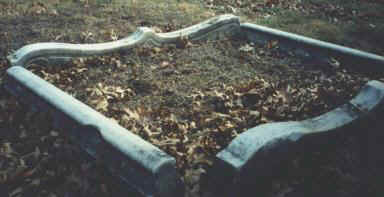 « Professionally made marble edging defines this small family plot at Midland. This style
of plot marking is adapted from late nineteenth century Euro-American burial
style. Its use cuts across all cultural boundaries and edging similar to
this can be found in many cemeteries across the country.
« Professionally made marble edging defines this small family plot at Midland. This style
of plot marking is adapted from late nineteenth century Euro-American burial
style. Its use cuts across all cultural boundaries and edging similar to
this can be found in many cemeteries across the country.
Another way to mark family plots, also adopted from
Euro-American practice, was to delineate the boundary of the plot with a wall
or fence. Some of the earliest African American cemeteries in St.
Helena, one of South Carolina's Sea Islands, use tabby, or oyster shell walls
to define family plots.8 This unique blending of African
symbolism--seashells representing the ocean voyage from Africa--combined with European
style walled or fenced plots, carries through to small Northern communities
such as Midland, where many plot boundaries are defined by homemade
walls. Concrete, brick and wood in homemade configurations contrast with
typical Euro-American plot outlines of granite, iron, and marble. There
are professionally produced plot boundary markers 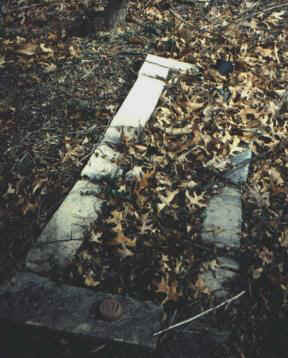 in use at Midland, signs of affluence in the African American community, or examples of the long held
African American belief in the need to provide a funeral and resting place
appropriate to the deceased, to assure that the spirit of the departed rests
in peace. Most plot boundary markers, however, are produced in the same
style of the homemade tombstones; made with care and craftsmanship by friends
to honor the deceased, rather than by strangers in a factory. Homemade
plot boundaries were being utilized as late as 1982, in the form of pre-cast
garden edging surrounding two separate plots.
in use at Midland, signs of affluence in the African American community, or examples of the long held
African American belief in the need to provide a funeral and resting place
appropriate to the deceased, to assure that the spirit of the departed rests
in peace. Most plot boundary markers, however, are produced in the same
style of the homemade tombstones; made with care and craftsmanship by friends
to honor the deceased, rather than by strangers in a factory. Homemade
plot boundaries were being utilized as late as 1982, in the form of pre-cast
garden edging surrounding two separate plots.
» Low granite curbing defines a single plot; one of many such examples at Midland.
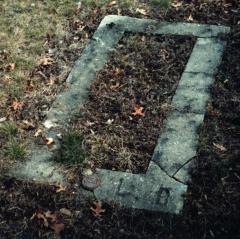
« This granite plot boundary includes the initials "L.B" on the right, and the single initial "J" on the left. It is among a grouping of three such plot styles.
To view more photographs of African American traditional family plot boundaries in use at Midland Cemetery, Click here.
Landscaping and Plantings
African American burial grounds are characterized by an almost complete lack of formal landscaping and ornamental plantings.9 Formal landscaping of American cemeteries came into vogue in the 1830's, following upon the success and popularity of such European cemeteries as London's Kensal Green (1827) and Père Lachaise in Paris (1804/1815). In the United States, the rural cemetery movement began with Mount Auburn Cemetery, in Cambridge, Massachusetts (1831), which was quickly followed by formally landscaped cemeteries in cities across the country. Harrisburg Cemetery, an exquisite example of this Romantic Movement landscaping, opened in 1845.
Despite the willingness of African Americans to blend
traditional African beliefs with Euro-American burial styles, the formally
landscaped burial ground is very seldom seen in older Black cemeteries.
In fact one of the major problems facing historic African American graveyards
is that they are often overlooked as unused property, with portions containing
unmarked graves mistaken for un-cleared land. Even local historian
Barbara Barksdale, who spearheaded the drive to clean up and preserve Midland
Cemetery, and who heads 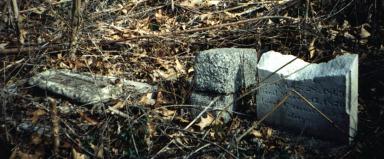 the Friends of Midland organization, did not initially
realize how extensive the burials at Midland were, mistaking large portions of
the cemetery for wild brush.10
the Friends of Midland organization, did not initially
realize how extensive the burials at Midland were, mistaking large portions of
the cemetery for wild brush.10
» Three grave stones, including at least one child's stone, at the edge of the cleared land at Midland. The lack of formal landscaping makes identifying cemetery land difficult at times.
Midland's uneven ground, sunken areas, spots of bare earth, and lack of clearly marked access roads or pathways is characteristic of older Black cemeteries across the country. There are worn areas, indicating convenient paths taken by visitors and maintenance crews, and an access area for vehicles near the 1999 monument, but it is not clear if these are historical paths or modern intrusions.
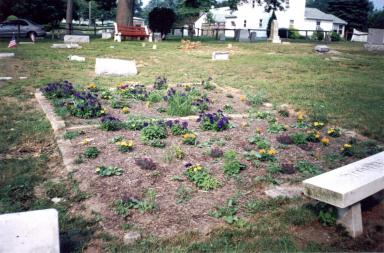 « The
Terrell family plot has been brightened with plantings of summer annual
flowers. Although this seems to defy the traditions outlined below, the
plantings are not traditional evergreen perennials as used in Euro-American
cemeteries. It is also the only such plot so treated at Midland.
« The
Terrell family plot has been brightened with plantings of summer annual
flowers. Although this seems to defy the traditions outlined below, the
plantings are not traditional evergreen perennials as used in Euro-American
cemeteries. It is also the only such plot so treated at Midland.
Compare this photograph, taken in June 2002, with the photo taken in March 2002 on page 5.
Similarly, Midland has very little in the way of vegetative landscaping. Mature hardwood trees border a portion of the southern boundary and dot the site here and there, but it lacks both the formal evergreen plantings of Euro-American cemeteries of a similar time-period, and the overarching tree canopy which makes up the sylvan setting as seen in Harrisburg Cemetery. This is neither a result of lack of grounds keeping or poor planning, but is very much in keeping with the traditional African, and African American, belief in the cemetery as the domain of the dead. Simplicity is dominant, and plantings, if they are utilized at all to mark or honor graves, are generally native plants. Any attempt at landscaping would be seen as an intrusion which would only disturb the dead; and the taboo against the disturbance of graves is one of the most strongly-held African American beliefs. The refusal of the African American community to romanticize death with park-like cemeteries has historically led to the false belief that Black cemeteries are frequently neglected. Solitude for the dead is prized above a soothing setting for the living.11
Conclusion
Midland Cemetery is not only a historically unique site that contains the graves of African Americans who figured prominently in the history of the area, but is equally invaluable as a repository of numerous examples of African American death and burial culture. Its layout, native vegetation, inventory of grave and plot markers, and style of burials all attest to a philosophy of burial and a belief in an afterlife that has direct African influences as well as being a unique blend of African and European traditions. As it stands today, Midland is a well preserved site that has much to teach about the African American experience in this part of Dauphin County.
Notes
1. For the story of how Midland was rescued from obscurity, see the Steelton Oral History Project detailing Midland Cemetery, and Barbara Barksdale, produced by the American Mosaic project of Dickinson College. (back to text)
2. Evidence of a strong east-west burial axis among slaves is found in an online article from the Monticello Newsletter (Vol. 12, No. 2, Winter 2001), "Slave Burial Ground is Identified at Monticello," http://www.monticello.org/press/newsletter/2001/burgr.pdf. (back to text)
3. For reasons associated with east-west burials, see Roberta Hughes Wright and Wilbur B. Hughes III, Lay Down Body: Living History in African American Cemeteries (Detroit, Visible Ink Press, 1996), page 20. Several online resources also explore this topic. Some of the most well presented articles are: South Carolina Information Highway's African American Cemeteries; Tennessee National Heritage Area, African-American Cemeteries--Significance, downloaded from the Middle Tennessee State University site on September 13, 2002( former url was http://chp.mtsu.edu/tncivwar/aacem/index.html, now a defunct link); and an excellent research paper by David Bruner, on Web Archeology. com "Hidden Power: Burial Practices from an African-American Slave and Tenant Community," which discusses many cultural aspects of African American burials. (back to text)
4. Burial near or in view of a body of water is very prevalent among Sea Islanders in SouthCarolina. See Wright and Hughes, page 48, for details of a lawsuit that resulted when development threatened the water link at a cemetery on Daufuskie Island, SC. A web page about the recently (1991) discovered African Burial Ground in New York City also mentions the tradition of burial beside or near water: "Beneath the Streets", by Antoinette Mullins, published online by Harlem Live at http://www.harlemlive.org/community/parks/burialground/index.html. See also the web page mentioned above, "African American Cemeteries", by SCIway. Two more websites discuss the importance of water, or a journey over water after death, to the African American community: "Update #4: New York's African Burial Ground" by Jerome S. Handler of Southern Illinois University, published online by African American Archaeology 12 (Winter 1994); and "History of Greenwood Cemetery" published online by the City of Tallahassee (Florida) Public Works Department at http://www.talgov.com/pubworks/gwhistory.cfm. (back to text)
5. SCIway, "African American Cemeteries;" Wright and Hughes, pages 18-21. (back to text)
6. For a good discussion of African American beneficial societies, see the chapter "Burial Societies and Lodges" in Wright and Hughes Lay Down Body. A perusal of Boyd's Directory of Harrisburg and Steelton for 1919 turns up several protective societies in Harrisburg that provided benefits, probably including burial benefits, to local African American citizens. Among those listed are four Masonic organizations:
- St. James Commandery, No. 18, K.T., (colored)
- Harris Chapter, No. 26, R.A.M., (colored)
- Easter Star Chapter, No 1, (colored)
- Mecca Temple, A.A.O.N.M.S., (colored)
The Knights of Pythias maintained three African American chapters in Harrisburg:
- Capital City Court of Calanthe, No. 328, auxiliary to Knights of Pythias (colored)
- Pythias Lodge, No. 34, Knights of Pythias (colored)
More specifically, the Negro Protective Association met periodically at 1220 N. 7th Street. A few doors away, at 1213, was the regular meeting place of Unity Lodge, No. 71, Improved Benevolent & Protective Order of Elks of the World, (colored). The words "protective" and "benevolent" indicate organizations whose purpose was not only social, but which provided vital sick and death benefits. The Steelton portion of the directory lists several ethnic benevolent societies and a fireman's protective association, but only one identifiable African American association, Golden Willow Tabernacle, No. 78, Galilean Fisherman (Colored). Whether this association was beneficial in nature or related more to religious or social means is not known at this time. The presence of beneficial societies for other groups shows that the practice was used in Steelton, though, and the African American groups may have been too informally organized to be included in a printed directory. (back to text)
7. Wright and Hughes, page 278. (back to text)
8. Wright and Hughes, page 91. (back to text)
9. SCIway, "African American Cemeteries;" Center for Historic Preservation, MTSU, African American Cemeteries. (back to text)
10. American Mosaic, Midland Cemetery. (back to text)
11. Center for Historic Preservation, MTSU, African American Cemeteries. (back to text)
More Midland Photo Galleries
Civil War Burials at Midland
World War Burials at Midland
Gallery of Home Crafted Memorials at Midland
Gallery of Plot Boundary Markers at Midland
Artifacts of a Historic Cemetery
Names of Persons Buried at Midland
Tombstone Transcriptions
All Names, A-Z
Other Pages
Steelton Death Certificates, 1892-1893
About the Friends of Midland
Special Feature: The People of Midland
Afrolumens Project Home | Enslavement | Underground Railroad | 19th century | 20th century